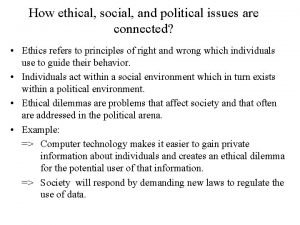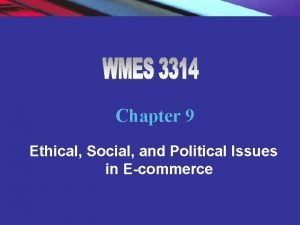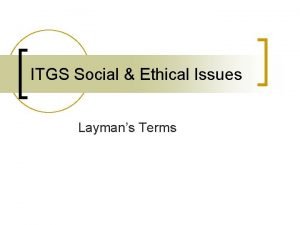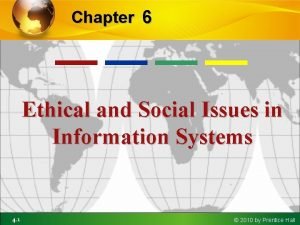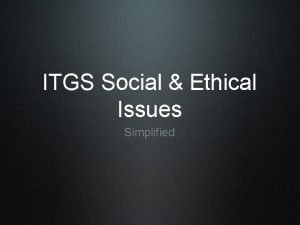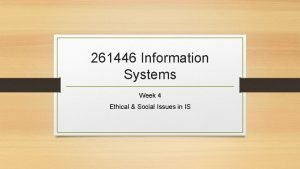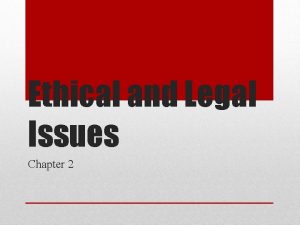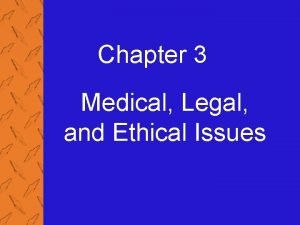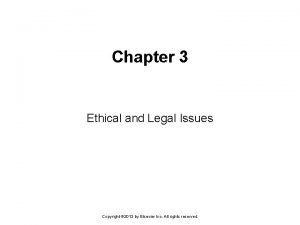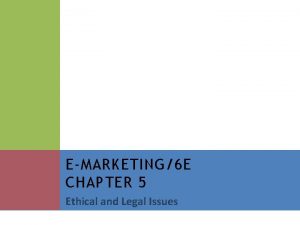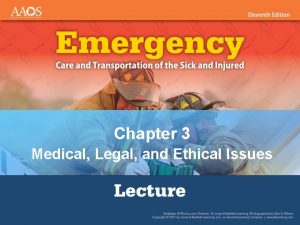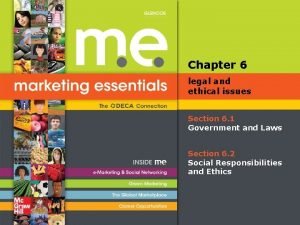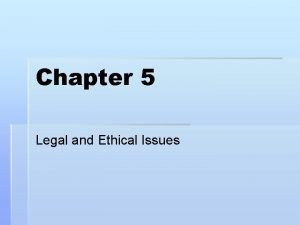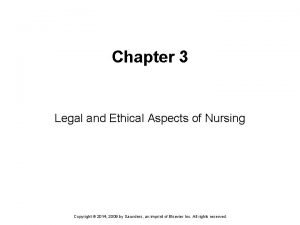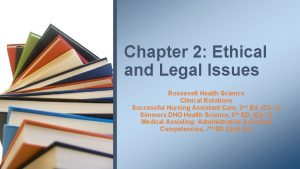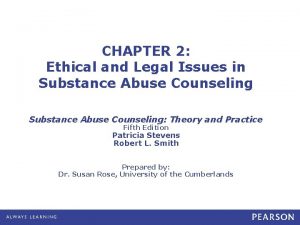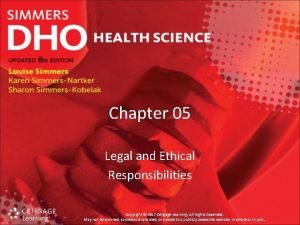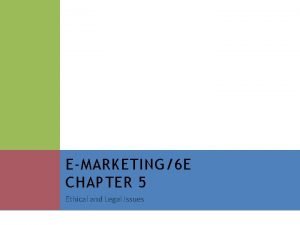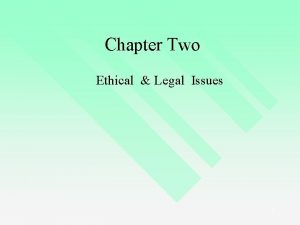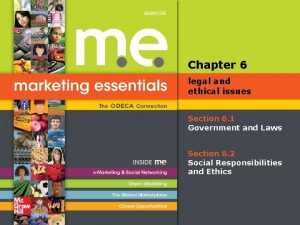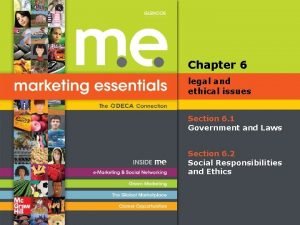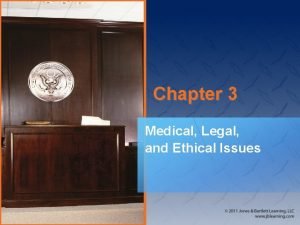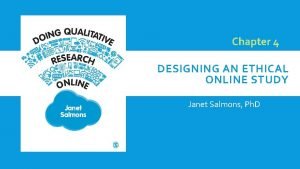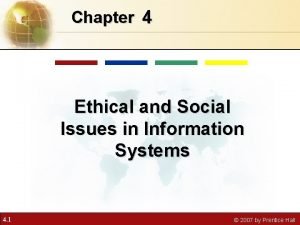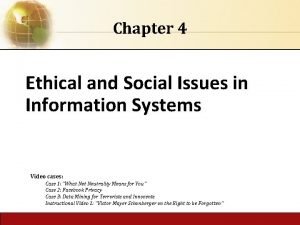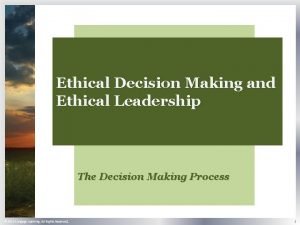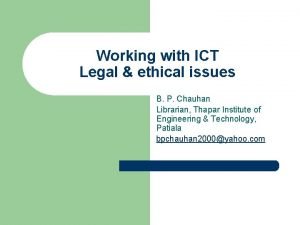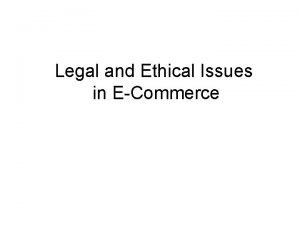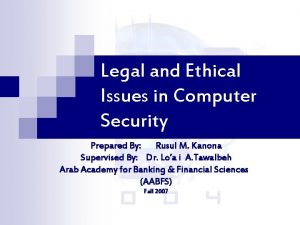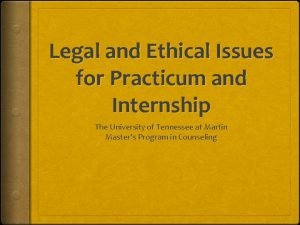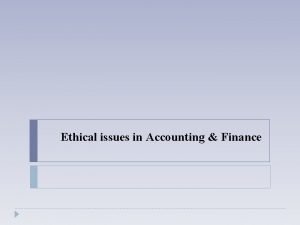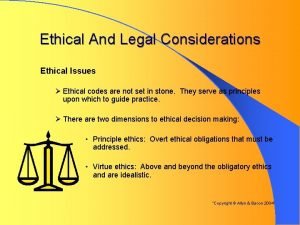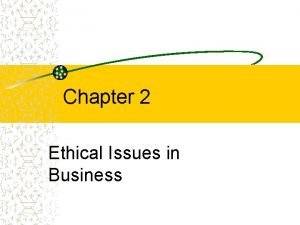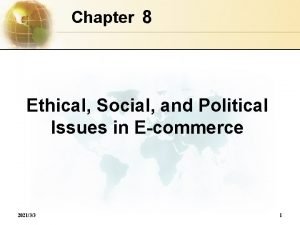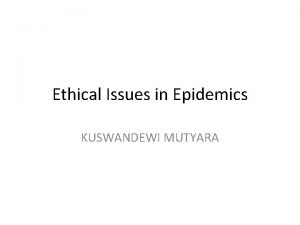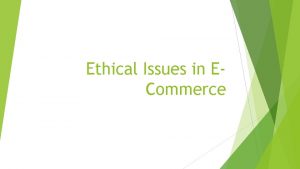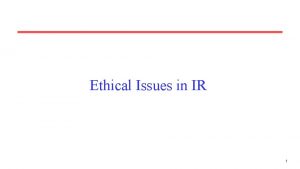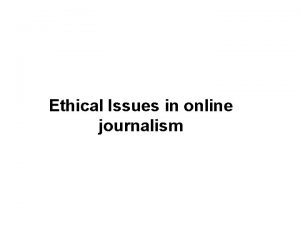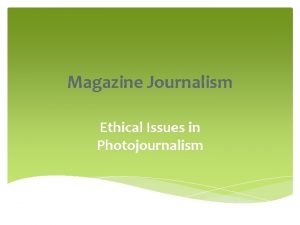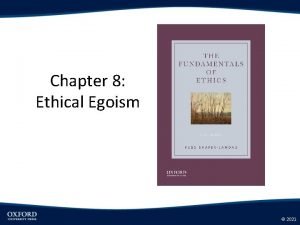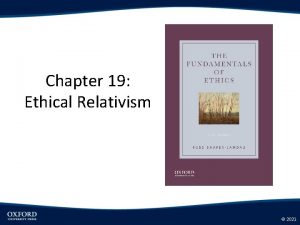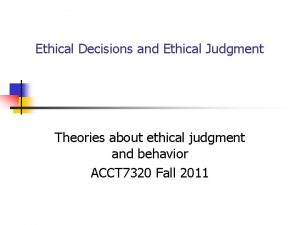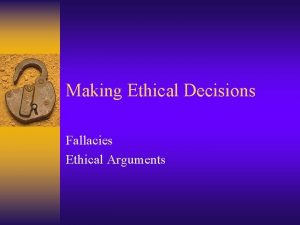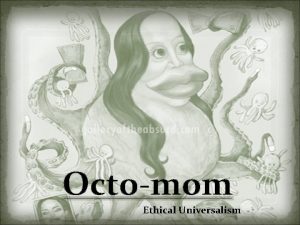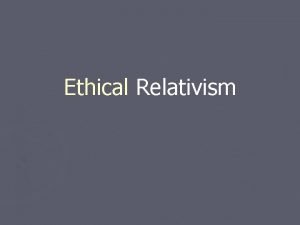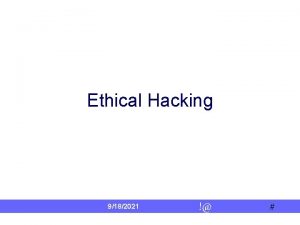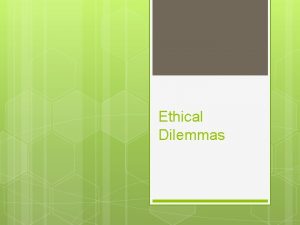Chapter 8 Ethical Social and Political Issues in



































- Slides: 35

Chapter 8 Ethical, Social, and Political Issues in E-commerce Copyright © 2009 2010 Pearson Education, Inc. Slide 8 -1

Basic Ethical Concepts Ethics -- The study of principles that individuals, organizations, and societies can use to determine right and wrong courses of action. Principles include: 1. Responsibility: As free moral agents, individuals, organizations, and societies are responsible for the actions they take 2. Accountability: Individuals, organizations, and societies should be held accountable to others for the consequences of their actions 3. Liability: Damages can be recovered based upon responsibility and accountability (legal enforcement of penalties for ethical violations) Copyright © 2006 Pearson Education, Inc. Slide 9 -2

Ethical Guidelines One or more of the following well-established ethical principles can be used to help you determine your actions when confronted with an ethical dilemma: § Golden Rule – do unto others… § Collective Utilitarian Principle – do whatever is best for society collectively § No Free Lunch – anything created of value is owned by someone and they deserve to be paid for it § The New York Times Test – how would you feel if your situation appeared on the front page of the paper? Copyright © 2006 Pearson Education, Inc. Slide 9 -3

Understanding Ethical, Social, and Political Issues in E-commerce n With each new technology that has emerged (steam power, electricity, phones, TV), there is both social progress and debate over what is ethical and what should be legal. n Internet technology and its use in e-commerce is challenging our existing beliefs regarding ethics and legality. n One thing is for sure – the internet is not and will not be regarded as “the Wild West” – GREAT quote at bottom of page 498 Copyright © 2006 Pearson Education, Inc. Slide 9 -4

E-Commerce features and their potential ethical and legal impacts (chart on 495) Ubiquity – surfing, e-mailing or shopping at work Ubiquity – using technology while driving Global Reach – US jobs going oversees Global Reach – erosion of national pride Universal Standards – ease of hacking and viruses Richness – persuasion of children Richness – replacement for reading Information Density – more info = more temptation for false info Personalization – enabling invasion of privacy Copyright © 2006 Pearson Education, Inc. Slide 9 -5

Four major categories of issues 1. Information rights – privacy matters 2. Property rights – music, books, movies, etc 3. Governance – who has jurisdiction for laws making/enforcement as well as taxation 4. Public safety and welfare – pornography, gambling, cigarette/pharmaceutical sales Copyright © 2006 Pearson Education, Inc. Slide 9 -6

1. Information Rights Privacy - The moral right of individuals to be left alone, free from surveillance or interference from other individuals or organizations Information privacy: Includes both the claim that certain information should not be collected at all, as well as the claim of individuals to control the use of whatever information is collected about them n Threats to privacy come from both the private sector (companies collecting/using info) and the public sector (governments collecting/using info) Copyright © 2006 Pearson Education, Inc. Slide 9 -7

E-commerce and Privacy Stats: • 55% of all companies store/review employee e-mails • 40% of all 9 -5 company internet surfing is not workrelated • About 40% of all B 2 C E-Commerce is done while at work • 76% of all US companies monitor employee web activity Q. What do you think is acceptable in terms of companies monitoring employee behavior? Q. Is monitoring web/e-mail activity by employees any different than using video cameras? Copyright © 2006 Pearson Education, Inc. Slide 9 -8

Information Collected at E-commerce Sites n Personally identifiable information (PII): Data that can be used to identify, locate, or contact an individual. Almost all e-commerce companies collect PII and use cookies to track clickstream behavior n Anonymous information: Demographic and behavioral information that does not include any personal identifiers n Information is used to profile consumers, both anonymously and personally. And customers are in general NOT aware that they are being “watched” as they click around and sent offers based upon their behavior (often with no consent) Copyright © 2006 Pearson Education, Inc. Slide 9 -9

Information Collected by the Government Since 9/11, the USA Patriot Act and Homeland Security Act have strengthened the ability of the government to monitor all of our offline and online activity. Q. How do you feel about that? ! Copyright © 2006 Pearson Education, Inc. Slide 9 -10

Information Collected at E-commerce Sites Marketers argue that… Ø The more personal data collected, the more precise the targeting of offers that benefit consumers Ø Consumers are willing to give up privacy to reap the rewards of convenience, personalization, and targeted offers Ø Profiling permits targeting of ads which benefits customers (offers they want) and businesses (elimination of waste from marketing to disinterested consumers) Q. How do you feel about these arguments? Copyright © 2006 Pearson Education, Inc. Slide 9 -11

Informed Consent n Informed Consent – consent given with knowledge of all the material facts needed to make a rational decision. As discussed before, “informed” consent is not always given nor required in E -commerce activities n Many U. S. e-commerce firms merely publish information practices as part of privacy policy without providing for any form of informed consent n Two models: § Opt-in – consumer must check “yes” for info to be collected/distributed § Opt-out – info will be collected/distributed unless consumer takes an action to negate it Copyright © 2006 Pearson Education, Inc. Slide 9 -12

FTC’s Fair Information Practice Principles Notice/Awareness Sites must disclose information practices before collecting data. Includes identification of collector, uses of data, other recipients of data, nature of collection (active/inactive), voluntary or required, consequences of refusal, and steps taken to protect confidentiality, integrity, and quality of the data Choice/Consent There must be a choice regime in place allowing consumers to choose how their information will be used for secondary purposes other than supporting the transaction, including internal use and transfer to third parties. Optin/Opt-out must be available. Access/Participation Consumers should be able to review and contest the accuracy and completeness of data collected about them in a timely, inexpensive process. Security Data collectors must take reasonable steps to assure that consumer information is accurate and secure from unauthorized use. Enforcement There must be in place a mechanism to enforce FIP principles. This can involve self-regulation, legislation giving consumers legal remedies for violations, or federal statutes and regulation. SOURCE: Based on data from Federal Trade Commission, 1998, 2000 a. Copyright © 2010 Pearson Education, Inc. Slide 8 -13

FTC Recommendations: Online Profiling Principle Recommendation Notice Complete transparency to user by providing disclosure and choice options on the host Web site. “Robust” notice for PII (time/place of collection; before collection begins). Clear and conspicuous notice for non-PII. Choice Opt-in for PII, opt-out for non-PII. No conversion of non-PII to PII without consent. Opt-out from any or all network advertisers from a single page provided by the host Web site. Access Reasonable provisions to allow inspection and correction. Security Reasonable efforts to secure information from loss, misuse, or improper access. Enforcement Done by independent third parties, such as seal programs and accounting firms. Restricted Collection Advertising networks will not collect information about sensitive financial or medical topics, sexual behavior or sexual orientation, or use Social Security numbers for profiling. Copyright © 2010 Pearson Education, Inc. Slide 8 -14

Private Industry Self-Regulation n The Online Industry opposes government regulation, preferring to regulate themselves. . . “Never let the monkeys guard the bananas” n To date, self-regulation has been ineffective in terms of profiling, usage of personal data, establishing requirement for opt-in, and any form of enforcing penalties for violations Copyright © 2006 Pearson Education, Inc. Slide 9 -15

So what’s driving privacy improvements? “While Internet advertisers have pretty much blocked effective legislature in Washington that would preserve privacy, and while their industry associations have quite clearly failed to bring about meaningful self-regulation, the market has responded by providing consumers with some powerful tools for protecting their own privacy. ” Copyright © 2006 Pearson Education, Inc. Slide 9 -16

Technological Solutions to Privacy Invasion on the Web n Pop-up, Spam, and Spyware blockers n Secure E-mail via encryption n Cookie managers n Platform for Privacy Preferences (P 3 P): A standard designed to communicate to Internet users a Web site’s privacy policy, and to compare that policy against user’s preferences or to other standards such as FTC’s FIP guidelines or EU’s Data Protection Directive Copyright © 2006 Pearson Education, Inc. Slide 9 -17

How P 3 P Works Figure 8. 2(A), Page 522 Copyright © 2010 Pearson Education, Inc. SOURCE: W 3 C Platform for Privacy Preferences Initiative, 2003. Slide 8 -18

Internet Explorer 6. 0’s Implementa tion of P 3 P Copyright © 2006 Pearson Education, Inc. Slide 9 -19

2. Intellectual Property Rights Intellectual property - Encompasses all tangible and intangible products of the human mind. In the US, the creator is the owner. n n Compared to books, CD’s, and paintings, anything online is easy and inexpensive to copy, distribute, alter, and use Goal of intellectual property law: v Balance two competing interests—public and private v Great quote in middle of page 528 Copyright © 2006 Pearson Education, Inc. Slide 9 -20

Intellectual Property Protection Three main types of protection: 1. Copyright 2. Patent 3. Trademark law Copyright © 2010 Pearson Education, Inc. Slide 8 -21

Copyright Law Copyright law: Protects original forms of expression (but not ideas) from being copied by others for a period of time of at least 70 years n Intent behind the laws is to provide financial incentives and protection to encourage creativity and completion n Protection is for whole work and its parts n Digital Millennium Copyright Act of 1998 (DMCA): First major effort to adjust copyright laws to Internet age. Made it illegal to make, distribute, or use devices that circumvent technologybased protections of copyrighted materials n Doctrine of Fair Use allows exceptions, such as the quotes I’ve taken from the book in this PPT deck Copyright © 2006 Pearson Education, Inc. Slide 9 -22

Patents Patent: Grants owner a 20 -year exclusive monopoly on ideas behind an invention n Intent was to ensure inventors were rewarded and the invention could possibly be used by others n Most of early inventions that made Internet and e-commerce possible were not patented by their inventors. With commercial development of Internet, came desire for patents n Virtually any software program can be patented provided it is novel and not obvious Copyright © 2006 Pearson Education, Inc. Slide 9 -23

Patents Examples of E-Commerce Patents: ü Amazon. com “One-click purchasing” ü Priceline. com “Name your price” ü Google’s search technology Copyright © 2006 Pearson Education, Inc. Slide 9 -24

Trademarks Trademark: Mark used to identify and distinguish goods, and indicate their source. Includes words, pictures, shapes, packaging, and colors. n Trademarks protect public by ensuring it gets what it pays for/expects to receive; protects trademark owner against piracy and misappropriation n Granted for 10 years and can be renewed indefinitely n The tests for infringement are market confusion and bad faith Copyright © 2006 Pearson Education, Inc. Slide 9 -25

Types of Trademark Abuse on Internet In the early days of the internet, domain names were first come, first served. Names were taken for profit or to benefit from confusion w/ known brand/company names n Cybersquatting: Registration of infringing domain name, or other Internet use, of existing trademark, for purpose of extorting payments from legitimate owners n Cyberpiracy: Involves same behavior as cybersquatting, but with intent of diverting traffic from legitimate site to infringing site n Keywording: Using another’s trademarks as keywords on search engines in a misleading or confusing manner Copyright © 2006 Pearson Education, Inc. Slide 9 -26

3. Governance Involves: § Who will control the Internet and e-commerce? § What elements will be controlled and how? § How the controls will be implemented? Currently, there is minimal government regulation with most of the governance coming from self-regulation. Other countries have proven that governments can successful govern the internet, but should they? Copyright © 2006 Pearson Education, Inc. Slide 9 -27

Government Oversight of the Internet One additional question… Q. Who should govern internet usage when it crosses borders? Copyright © 2006 Pearson Education, Inc. Slide 9 -28

Net Neutrality n Currently, all Internet traffic is treated equally —all activities charged the same rate, no preferential assignment of bandwidth n Backbone providers would like to charge differentiated prices and ration bandwidth n FCC has indicated it will propose rule in favor of maintaining net neutrality Copyright © 2010 Pearson Education, Inc. Slide 8 -29

Taxation “Cheese may be taxable in one state as a snack food but not taxable in another state (such as Wisconsin), where it is considered a basic food” Beyond that important fact, there’s been virtually no resolution to the question of how to uniformly tax E-commerce transactions. Copyright © 2006 Pearson Education, Inc. Slide 9 -30

4. Public Safety and Welfare Major Issues: Ø Protection of Children Ø Pornography Ø Gambling Ø Pharmaceutical and Cigarette Sales Copyright © 2006 Pearson Education, Inc. Slide 9 -31

Public Safety and Welfare Protection of children n Issues include pedophiles communicating with children, child pornography, and collecting info on minors n COPPA – prevents E-commerce sites from collecting info from minors without parental permission n CIPA – requires schools and libraries to install filtering software to protect children from pornography n Domain Names Act – prevents domain names which may lure children into pornography Copyright © 2006 Pearson Education, Inc. Slide 9 -32

Public Safety and Welfare Pornography *70 million people visited porn sites in August of 2005 *There were over 15 Billion pages of content at that time *There an estimated 1. 3 Million porn sites *Estimated revenue for the industry is $5 -$10 Billion annually Q. What opinions do you hold regarding entrepreneurship clashing with ethics in this enormous E-commerce industry? Copyright © 2006 Pearson Education, Inc. Slide 9 -33

Public Safety and Welfare Gambling v There are more than 2, 000 gambling sites on the web v Annual revenues worldwide exceed $12 Billion, with over 80% coming from US citizens v 70% are males 18 -34 with average income of $70 k Governance – virtually none. The only success has been convincing some large E-commerce companies to avoid advertising and not support financial transactions. That said, have you heard of Fantasy Football or March Madness? ! Copyright © 2006 Pearson Education, Inc. Slide 9 -34

The Internet Drug Bazaar (page 554) Class Discussion n What’s wrong with buying prescription drugs online, especially if the prices are lower? n What are the risks and benefits of online pharmacies? n How do online pharmacies challenge the traditional business model of pharmacies and drug firms? n What are the challenges in regulating online pharmacies? n Who benefits and who loses from online pharmacies? Copyright © 2010 Pearson Education, Inc. Slide 8 -35
 How ethical social and political issues are connected
How ethical social and political issues are connected Ethical social and political issues in e-commerce
Ethical social and political issues in e-commerce Chapter 4 ethical and social issues in information systems
Chapter 4 ethical and social issues in information systems 4 components of an information system
4 components of an information system Professional issues ethics and computer law
Professional issues ethics and computer law Social ethical issues itgs
Social ethical issues itgs Ethical and social issues in information systems doc
Ethical and social issues in information systems doc Ethical and social issues in information systems doc
Ethical and social issues in information systems doc Itgs social and ethical issues
Itgs social and ethical issues Ethical and social issues in information systems
Ethical and social issues in information systems Ethical and legal issues chapter 2
Ethical and legal issues chapter 2 Medical legal and ethical issues chapter 3
Medical legal and ethical issues chapter 3 Chapter 3 legal and ethical issues
Chapter 3 legal and ethical issues Legal and ethical issues chapter 5
Legal and ethical issues chapter 5 Medical legal and ethical issues chapter 3
Medical legal and ethical issues chapter 3 Chapter 6 legal and ethical issues
Chapter 6 legal and ethical issues Chapter 5 legal and ethical issues
Chapter 5 legal and ethical issues Legal and ethical aspects of nursing
Legal and ethical aspects of nursing Ethical and legal issues chapter 2
Ethical and legal issues chapter 2 Ethical and legal issues chapter 2
Ethical and legal issues chapter 2 Chapter 5 legal and ethical responsibilities
Chapter 5 legal and ethical responsibilities Legal and ethical issues chapter 5
Legal and ethical issues chapter 5 Chapter 2 ethical and legal issues
Chapter 2 ethical and legal issues Chapter 6 legal and ethical issues
Chapter 6 legal and ethical issues Chapter 6 legal and ethical issues
Chapter 6 legal and ethical issues Medical legal and ethical issues chapter 3
Medical legal and ethical issues chapter 3 Ethical issues in qualitative research chapter 4
Ethical issues in qualitative research chapter 4 Chapter 4 ethical issues
Chapter 4 ethical issues Chapter 4 ethical issues
Chapter 4 ethical issues The writer properly quotes and cited sources in some places
The writer properly quotes and cited sources in some places Ethical habits
Ethical habits Legal and ethical issues in use of ict in education
Legal and ethical issues in use of ict in education Legal issues of ecommerce
Legal issues of ecommerce Legal and ethical issues in computer security
Legal and ethical issues in computer security Ethical and legal issues involved in practicum
Ethical and legal issues involved in practicum Ethical issues in accounting
Ethical issues in accounting
